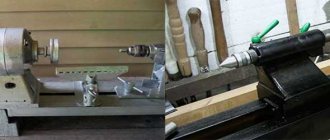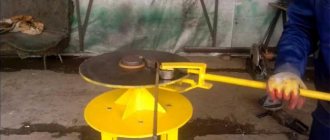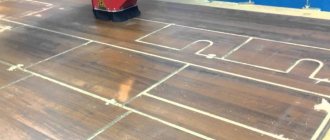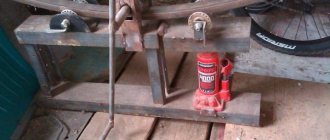In construction work, laying a solid foundation, the construction of various metal structures is required, where it is necessary to use reinforcement of different diameters and sizes.
Concrete buildings experience the greatest loads in places of bends and corners, and this leads to rapid destruction.
Therefore, steel frames used for strengthening make it possible to give the structure durability and wear resistance. How to properly prepare and bend reinforcement for foundations, what machines or devices exist for this will be discussed later in this article.
Using steel pipes for bending reinforcement
After calculating the amount of reinforcement and purchasing it, it becomes necessary to carry out work on it with your own efforts. This can be done using some available tools. The first method involves the use of steel pipes, which are first dug into the ground or concreted. The inner diameter of the pipe should be small.
The fittings are lowered into the pipe to the required length and the outer part is bent to the side until the required angle of inclination is obtained. Helpers may be needed when bending. To simplify the procedure, you can additionally put a second piece of pipe on the rod.
When arranging the foundation, you can use another method. To do this, you will need two pipes, the diameter of which should not be much larger than the diameter of the rod. You also need to pay attention to the length of the pipes; you will need to put in less effort if you choose a longer pipe.
• Two pins are driven into the ground.
• Pipes are put on the rod on both sides.
• By supporting the reinforcement on the pin, it is quite easy to bend it, reaching the required radius of curvature.
Instead of pins, you can use other similar devices at hand.
Using welding to bend reinforcement
The use of welding is possible in cases where there are no requirements to maintain thickness. In this case, the reinforcement is heated at the site of the future bend. The metal becomes ductile and bends easily.
You can also heat the rod using a blowtorch. In this case, the reinforcement must be secured in a vice if it is not possible to ask someone for help. After heating the rod, it is bent with a hammer or by hand.
There are many other methods for heating reinforcement, but it should be remembered that this bending method is not recommended for structures intended for high loads. Therefore, it is better to consult with specialists.
Bend a pipe at home
When installing heating pipes, it may be necessary to bend the pipe. This procedure is performed as follows.
• A spring of the same diameter is inserted into the pipe, which will prevent possible rupture. Then they begin bending the pipe. Remove the springs using wire.
• Another method involves using sand to fill the pipe. After this, it is clamped in a vice and heated at the intended bend. The degree of heating of the pipe is judged by its color, which should turn bright red. You can make sure that the required temperature has been achieved by holding the paper close to the pipe. If it is charred, then the metal is ready for bending. Galvanized structures should not be bent when hot, as this may damage the coating.
• Bending pipes for heating a private house with thick walls is carried out using a grinder and welding. Having calculated the radius of the required curvature, cuts are made. After bending the pipe, the cuts made are welded.
Plastic pipe bending
When bending plastic pipes used in heating systems, the following steps are performed.
• Using fiberboard, make a frame that will give the pipe the desired shape.
• In order to prevent chips and scratches when bending plastic, the frame is filled with silicone, selected according to the shape.
• The pipe is then placed in the completed shell and heated.
• As the plastic heats up, it will begin to fill the frame, giving it the desired shape.
• After ten minutes, the pipe is removed and allowed to cool.
- BASKET
Reinforcement in construction is necessary, first of all, for reinforcing concrete. This connection allows you to transfer compressive and tensile forces to the reinforcing bars. This is simply necessary when building a foundation, since concrete has little resistance to such loads.
| Armature |
It is not correct to reinforce with connections made of straight rods; this weakens the structure, which can lead to various unpleasant consequences, for example, delamination of the foundation. Therefore, bending of reinforcement is necessary both to create corner ties of curved rods and to create various elements, for example, legs, hooks, etc. Fiberglass rods can only be bent at the enterprises that produce them. If you try to bend it with your own strength, it will simply burst. Metal reinforcement is bent strictly mechanically; no sharp corners should be allowed at the bending point.
Read also: Husqvarna 142 stalls when pressing gas
There are still several popular methods that are not advisable to use for bending rods. This:
- The angle grinder undercut the bend area
- Heating the bend area to a high temperature with a blowtorch, etc.
These manipulations greatly reduce the characteristics of the reinforcement, which can lead to their destruction. And it is better to use them only when the result does not affect the quality of the entire structure.
Bent reinforcement in concrete.
Any type of metal rod bends only cold without any cuts or other violations of the integrity of the rod. Moreover, each type can be bent to a certain angle, after which it will lose strength. For example, type A3 reinforcement can be bent at an angle of no more than 90 degrees without loss of strength. When bent 180 degrees, strength decreases by at least 10%.
All equipment for bending reinforcement can be divided into several categories
Drive equipment operates according to the following scheme
A thrust roller is fixed to the stand, and a disk is installed on the vertical shaft, on which the fingers (bending and central) are fixed. Bend rods are placed between them. When the disk begins to rotate in a horizontal plane, the laid rod rests against the roller and bends under the influence of the bending pin. The bending finger moves from the outside of the rod.
Bending machines, depending on the rods, are also divided into equipment:
- For bending rods from 3 to 20 mm.
- For bending rods from 20 to 40 mm.
- For bending rods from 40 to 90 mm.
- For bending rods from 3 to 90 mm.
Hydraulic machines are usually used when it is necessary to make several complex bends at an angle of up to 180 degrees. Such equipment bends rods without any defects that strain the metal.
Manual bending equipment comes in many types and can even be portable. Usually installed on a workbench for more convenient use. Much cheaper than other options and completely easy to use. The tool is suitable for small amounts of work.
Before purchasing a tool, you must know the scope of work, timing and diameter of the rods to be bent. In addition, you need to remember that the outer part of the reinforcement is more susceptible to tensile loads, while the inner part is more susceptible to compression. If you choose the wrong equipment or use it not according to the instructions, you can easily damage both the fittings and the machine. Therefore, before use, you should correctly configure the structure and, when using it, correctly clamp the reinforcing bar in it.
One of the devices for bending reinforcement
When special care and precision is not required, you can bend the rods even with your own hands. If you have strong hands and a rod with a diameter of 8 mm, this is not a problem. Two steel pipes will facilitate the process and improve the quality of the bend. The longer the pipes, the larger the diameter of the rod that can be bent.
The process itself is completely simple:
- The rod is inserted into the first, fixing pipe to the point of bending.
- The second pipe will be used as a lever. it is put on the other end of the reinforcement and guided in the desired direction.
- The reinforcement is bent.
For convenience, the fixing pipe is rigidly fixed in a vice, buried in the ground, etc.
A modification is also possible when both pipes are firmly buried or driven into the ground. The rod is inserted between the pipes and bent into the desired position.
An example of a homemade machine for bending reinforcement
If you have started building a new house, then to strengthen the concrete foundation you will need to make a reinforced frame. Reinforcing rods are produced, like any rolled metal, exclusively in straight form. But in order to make a frame from reinforcement, it must be bent in a certain way. Moreover, this operation will have to be performed directly at the construction site. There is only one rational solution - this is to make a machine for bending reinforcement with your own hands.
Read also: Construction of a cyclone for woodworking
The time and money spent on a homemade machine for bending reinforcement will pay off even at the stage of building the foundation of your house. It can also be used in the future. For example, for the manufacture of embedded parts, such as window or door lintels. But even after this, it will be useful to you more than once for assembling various steel structures.
Three methods of tying reinforcement cages
To form the metal frame of the base, three strapping methods are used:
- Welding. At first glance, welding is the simplest and most effective way to connect reinforcement, but in practice everything looks different. During welding, the metal is heated to high temperatures and deformed, which results in a partial loss of rigidity. You also have to hire a professional welder who knows about the properties of the metal and can avoid burning it, and this is an additional financial expense. There is also a risk of destruction of the welding site during operation of the industrial vibrator. Difficulties arise if you bend metal close to the welding site.
- Connection using bent wire or plastic clamps (ties). This method is popular among many developers, since the connection can be made with your own hands in a matter of minutes. If flexible wire is used, then a special tool must be used to connect the links. Plastic clamps are more reliable than wire, but are more expensive. The connection diagram is similar, only then you have to bend the rods at the required angle.
- Overlapping. This method involves overlapping reinforcement with further fixation with wire. It is practiced more for horizontal belts made of mesh, and a vertical smooth rod is used inside the joint.
Any of the above methods can be implemented with your own hands. In this case, you have to bend the metal, which is quite problematic, given the rigidity of the reinforcement and its minimum diameter for horizontal chords of 12 mm.
The principle of bending reinforcement
Bending a reinforcing bar is a process of controlled change in the direction of the central axis. In this case, at the point of deformation, some layers of metal will stretch, while others will compress.
One of the main determining factors during bending is the amount of force applied to the site of deformation. It directly depends on the type of steel and the cross-sectional diameter of the reinforcement. Thus, you can immediately decide that the better and thicker the reinforcing bar, the more force you will need to apply to bend it.
These definitions should serve as the basis for further calculations when making a device for bending reinforcement with your own hands.
If there are no special tools
It is possible to bend reinforcement (up to 8 mm) for the foundation without a specialized machine. But there is one nuance here - there will be no precise control over the bend radius. This impairs the strength and durability of the structure. This option is more appropriate for rods that will perform the structural function of the frame.
The work is carried out in stages:
- Strong bolts and dowels are fixed to a workbench or to a strong pole or wall at a distance of 15-20 cm;
- a mark is placed on the reinforcing bar at the future bend point;
- the fittings are inserted into a metal tube-lever (wider in diameter), which should not reach the marked point by 2-4 cm;
- the structure is placed with a marked point at the top bolt and on the right side of it, the lower part - to the left of the bottom bolt;
- exerting physical force on the lever (from top to bottom), bend the rod to the desired bend (to the left).
The result is a neat and precise bend of the required configuration in minutes.
Note! The bolts should be thick, and their heads should be higher than the reinforcement being processed, for a clearer fixation.
An even simpler option without machines and devices is possible. All you need is a construction meter (to mark dimensions), a peg and boards. Bend the reinforcement step by step:
- a mark peg is placed on the ground and a board is laid from it at a given point;
- the reinforcement is placed on the board (its end touches the peg) and covered with a second board on top;
- place the leg on the second board from above and fix it;
- take the reinforcement by hand and gently pull it towards you (away from the peg), giving the required bend.
How to bend reinforcement without a special device
And yet, let's start with the fact that you urgently need to bend a small amount of thin metal rod. To do this, we will look at several ways to bend reinforcement using improvised means.
Here it is worth knowing that when trying to bend, especially alloyed reinforcement, with your own hands you need to consciously calculate your actions, otherwise this can lead to serious injuries. Alloyed rolled metal, if you try to deform it, will try in every possible way to spring back and can cause irreparable harm to your health. So be careful and attentive.
Let us highlight the three simplest ways to bend reinforcement with a diameter of up to 8 mm yourself without the use of special devices, namely:
- Using two pieces of metal pipe. So, we will need tubes with a diameter of 15 mm with a length of 0.5 and 1 meter, which we put on the fittings. We stand on a half-meter piece of pipe with our feet, and, accordingly, we begin to lift the meter piece to the bend angle we need.
- If a five-centimeter piece of pipe 25-32 mm in diameter is electric welded to a one and a half meter metal pipe of 32 mm in diameter or a 50 mm steel angle, you will get a universal bending lever. All that remains is to either stand on the reinforcement or rest it against something strong.
- Not very long pieces of reinforcement can be bent using a large vice and a sledgehammer. Only with this method you shouldn’t rush and you need to hit with a little force, stretching the process, otherwise you can simply break the reinforcing bar.
The main disadvantage of using such methods for bending reinforcement is that the turning radius is quite large and often the angle turns out to be somewhat curved and does not lie with its sides strictly in the same plane.
Although, with good physical data and small diameters of the metal rod, these methods, as a rule, in practice are the most versatile benders at home.
Additional Tips
The following nuances should be taken into account to maintain the strength of the frame.
To get a high-quality result, you should not file the bending rods or heat them. This will weaken and destroy the metal.
The equipment must be chosen correctly. If you try to bend larger diameter rebar or do not set up the machine, the loads on the inner and outer surface of the metal will not be balanced. Fractures will appear on the bend and the part will quickly collapse.
You can bend thin rods by hand only for small buildings, because the bend radius will be large. As a result, the functionality of the design will decrease.
Watch an interesting video:
Reinforcement made from composite materials cannot be bent. It is cut with a grinder, a hacksaw or a bolt cutter.
If you bend the reinforcement correctly, the foundation will be strong and the house will last for many years.
How to make a device for bending reinforcement
If, nevertheless, the volume of work is large and you have enough technical knowledge, then anyone can make a manual bending machine for reinforcement with their own hands, so it’s all the more not worth buying it on the construction market.
Before starting production, it is necessary to make detailed drawings of the components of the future device. To do this, it is recommended to familiarize yourself with ready-made samples on the Internet, made according to a standard scheme, or choose some other technique than bending reinforcement.
A simple do-it-yourself reinforcement bender is easiest to do, based on the general principle of operation of this kind of device, namely, consisting of three main parts:
- massive base,
- rotating mechanism in the form of a large lever,
- strong support.
To make such a device, improvised materials and tools available in any normal garage are quite suitable. So, let's prepare the necessary tools for this, here we will need:
- angle grinder with cutting wheels and grinding disc,
- electric drill with a set of metal drills,
- electric welding machine with electrodes,
- standard set of hand tools.
Read also: How to melt duralumin at home
Although an important step is the preparation of components and assemblies, here we will try to adapt various available materials. As a last resort, what is missing can be borrowed either from a neighbor or purchased in addition on the construction market.
Sequencing
- Let's make the base. To do this, we take sheet metal 3-5 mm thick, measuring 100 by 200 mm, or you can take a piece of channel size 10-15, 200-300 mm long. We drill holes in the corners of the base to allow fastening to a workbench or other massive object. An axial stop is firmly welded in the center of the structure using electric welding. This is a steel shaft with a height of 50 mm and a diameter of 14 mm. For this part, you can take any M14 bolt of suitable size, the head of which must be sanded off, leaving a thickness of 3 mm - this will make it possible to create a strong welded connection with the base.
- We make a rotating mechanism. A steel strip 5 mm thick, 50 mm wide and at least one meter long is suitable for this. In the absence of a strip of the required length, you can take a shorter one, but weld the length of the lever using a steel pipe 32-50 mm in diameter. To one edge of the strip we electric weld a piece of metal pipe 50 mm long and 15 mm in diameter, which will fit like a roller on the axial stop. We retreat 50 mm from the roller along the longitudinal axis and weld a rotary stop, for which an M10 steel bolt, also with a pre-ground head, is suitable. You can also make and put a ring on the rotary stop, which will serve as a roller, which will improve the operation of the device. As an option, you can make a lever from a 50 mm steel angle; to do this, you need to cut off 50 mm of the shelf vertically at the point of attachment to the axial stop; the remaining part of the shelf will serve as a rotary stop.
- We electric weld a fixed stop to the base, for which a 50 mm piece of angle 50-100 mm long is suitable. The place of its attachment should be 100-200 mm from the axial stop with a displacement from the central axis of the base of no more than 20 mm, which is determined by the thickness of the reinforcement.
- We assemble the finished structure. We firmly attach the bases of our finished device to a mechanic’s workbench or other similar massive object in the surrounding environment. We put the rotating mechanism roller with a lever on the axial stop.
- We run in the finished machine for bending reinforcement and check its operation at idle, using soft metal for this. If everything works, then we begin to manufacture the parts we need from the reinforcement.
If the machine for bending reinforcement has its own stationary frame, then it is worth advising to make a couple of additional improvements to it, namely:
- apply linear markings on both sides of the axial stop, which will allow you to measure the length of the bent part of the bar without using a tape measure;
- Apply radial markings of the main angles of 30, 45 and 60 degrees around the axial stop, which will also make working on such a machine much more convenient.
Types of machines and their features
Reinforcement for reinforced concrete structures: a – rod, class A-II; b – class A-III, A-IV, A-V and A-VI; c – wire, class VR-II; d – reinforcing ropes.
Such machines can be pneumatic, hydraulic, manual, electromagnetic and electromechanical. The simplest ones are manual machines; they are convenient because their weight is not very large and there are options for portable structures. Of course, there are also limitations, that is, you can only use them to bend reinforcement with a diameter of no more than 14 mm. Such machines are not suitable for large volumes of work, but they are quite suitable for private construction.
- Stationary machines with a mechanical drive for bending foundation reinforcement increase the volume of work performed, and they can also bend reinforcement of a larger diameter than conventional manual ones.
- For higher quality and simplified work with large volumes, it is better to use machines that do not require the use of force, such as hydraulic and pneumatic devices.
They are usually used in workshops where metal structures are produced, where you can drive up and where, for a fee, they will do the necessary work in a short time. The hydraulic bending machine is ideal for the production of complex metal structures during foundation construction. It allows you to bend reinforcing bars with better quality. After bending, there are no folds or kinks left on the surface of the rod; the bend angle can reach up to 180°.
Alternative ways to work with reinforcement
If you are still going to professionally manufacture various metal structures yourself, then it is worth advising you to purchase an inexpensive factory-made machine that will have a lot of useful devices in its design. Typically, such machines operate on an electric drive and have:
- moving part,
- several shafts,
- double-sided stops.
You can see how such a factory machine for bending steel reinforcement works in this video.
But in order to fully understand the physics of the processes taking place and avoid defects in your work with various metal profiles, the following table will be useful to you:
Application area
The scope of application of reinforcing clamps is wide:
- civil and industrial monolithic construction;
- production of metal structures - fences, frames, cages, nets;
- reinforcement of brickwork;
- private construction - pouring foundations, installing concrete and stone fences, erecting walls of residential buildings.
An example of a reinforcement cage with clamps made of corrugated reinforcement, when reinforcing the grillage of a pile foundation.
Advantages
The use of reinforcement clamps provides several advantages:
- Reducing construction costs. Manufacturing does not take much time, installation significantly reduces the final cost of the structure compared to the use of additional fittings, and increases the service life of the product.
- Simplicity and speed of installation. Using reinforcement clamps it is possible to create any spatial frames with the required parameters.
- Possibility of using clamps of any configuration and size.
- No waste during installation of products.
We make clamps
The most common method of tying a reinforcement cage in the manufacture of strip foundations, columns, beams and crossbars is the use of clamps, which help protect the reinforcement from shifting when laying concrete. The installation step of the clamps is 30-50 cm, so you will need a lot of them. However, they must be the same in shape and size.
The wire must first be cut into pieces equal in length to the perimeter of the clamp plus 10 cm. If the wire is coiled in a coil, then it is convenient to make a semicircular template in the shape of the coil from the first piece and cut the remaining pieces of wire without unwinding it. The resulting bent pieces of wire must be straightened with a hammer on a wooden block.
Material influence
All construction reinforcement, in accordance with GOST 5781 (for hot-rolled steel), is divided into the following strength classes:
- A-I, or A240 - round or square bars made from steel type St. 3 (GOST 380);
- A-II or A300 - round or square bars made from steel St. 5, or Art. 5 Gps (GOST 380);
- A-III or A400 - bars of a periodic cross-section with longitudinal, transverse or diamond-shaped notches, which are made from low-alloy construction steels of type 10G or 12GS in accordance with GOST 27772;
- A-IV or A600 - round, square or periodic profile bars made of medium-alloy building steel grades 25G2S, 30 GS, etc.
When constructing buildings with a higher number of storeys, reinforcement is also made from more durable steel grades, for example, 30ХС2, 40Г, etc.
Reference values for some of the specified grades of materials, necessary for the correct development of bending technology, are summarized in the table:
Note. a is the minimum diameter of the mandrel at which the bent workpiece does not form cracks; d is the diameter of the reinforcing bar.
Thus, bending workpieces made of construction medium-carbon steels imposes noticeable restrictions on the final configuration of the product, determined primarily by the bending radius of the reinforcement.











